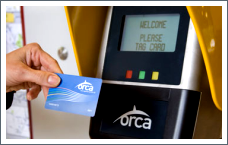What do you know about ORCA LIFT? My hope is that you’ve already heard of this program, and if you’re eligible, you already have your LIFT card! But – in case not – the ORCA LIFT program is a new reduced fare initiative, created by King County Metro. This means, that if your income falls within the 200% of the federal poverty level – you are likely eligible for this card.
ORCA LIFT’s reduced fare of $1.50 per ride (or $54 for the PugetPass which provides you with monthly unlimited rides) works on all Metro buses, the light rail, Kitsap Transit, the water taxi to West Seattle, and the Seattle Streetcar. Sound Transit and Community Transit buses are not participating in LIFT – so the reduced fare does not apply on these bus lines and you have to pay full bus fare. But you can tap the LIFT card and apply the $1.50 LIFT fare towards the full bus fare, and then pay the additional $1.25 to pay the full fare to ride.
If you already have a senior card or a disabled card – don’t worry! The card you already have is a better deal – only $1.00 and less than what you’d pay with the ORCA LIFT card.
Not sure if you’re eligible? Here is the income breakdown, by household size:
- For one person (with no dependents), you’re income eligible if you make $23,540 or less;
- For a household of two, the maximum income to qualify is $31,860;
- For a household of three, the maximum income to qualify is $40,180;
- For a household of four, the maximum income to qualify is $48,500; and so on.
 Still not sure if you qualify? Give us a call. Here’s my phone number: 206.461.4494 and here is ORCA LIFT Project Coordinator Natalia Arredondo’s phone number: 206.461.4482.
Still not sure if you qualify? Give us a call. Here’s my phone number: 206.461.4494 and here is ORCA LIFT Project Coordinator Natalia Arredondo’s phone number: 206.461.4482.
Prefer to do a little research online? Read about ORCA LIFT on Metro’s website here.
Want to sign up for a LIFT card?
We have community drop-in hours in downtown Seattle, White Center and Redmond. Please bring your government-issued ID and proof of income (30 days of paystubs, award letter from DSHS or the unemployment office, or your ProviderOne card). If you have questions about what to bring, please call Natalia at 206.461.4482.
YWCA Opportunity Place (2024 Third Avenue, Seattle, WA 98121)
- Mondays 10am-noon
- Tuesdays 11:30am-1:30pm
- Thursdays 10am-noon
YWCA Greenbridge (9720 8th Avenue SW, Seattle, WA 98106)
- Tuesdays 1pm-4pm
- Thursdays 1pm-4pm
YWCA Family Village Redmond (16601 NE 80th Street, Redmond, WA 98052)
- Mondays 9:30am-4pm (closed for lunch noon-1pm)
- Wednesdays 9:30am-4pm (closed for lunch noon-1pm)
- Thursdays 1pm-4pm
- Fridays 9:30am-4pm (closed for lunch noon-1pm)
Maybe none of our locations work for you. If that’s the case – check out drop-in locations at other organizations.


